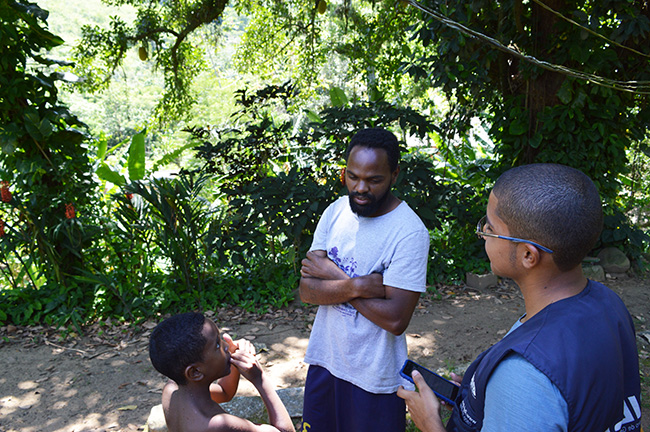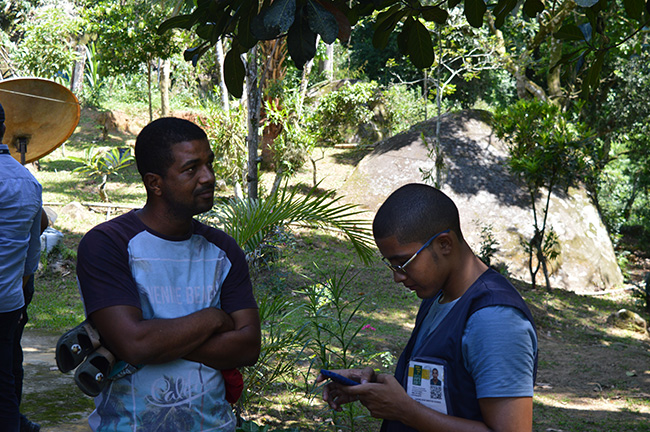Census of Agriculture collects data from quilombola communities in Rio de Janeiro
February 19, 2018 09h00 AM | Last Updated: June 05, 2018 03h48 PM
The data collection team in charge of the Census of Agriculture in Rio de Janeiro visited, between January 18 and February 2, several quilombola families that live and produce agricultural items, at the Pedra Branca State Park, located in Vargem Grande, in the western area of the city. That conservation unit is the territory of the quilombola community called Cafundá Astrogilda, born more than two centuries ago, but only in 2014 acknowledged as a quilombo by the Palmares Foundation – a federal public institution responsible for the identification and promotion of Afro-Brazilian art and culture.
Cafundá, which comes from the word cafundó, is the name of the road that leads to the Community, meaning distant, faraway place. Astrogilda was the woman who managed, between 1934 and 1962, together with her husband, Celso dos Santos Mesquita, an Umbanda house of great relevance to the community. Nowadays, one can find at the place family agriculture and animal raising, mostly as subsistence practices.
Before the visit, some quilombolas did not know they would be considered farmers according to Census standards. Families descend from ex-slaves who used to work in a coffee farm located behind Morro Redondo. After the abolition of slavery, the workers made a deal with the owner of the farm to work in exchange for a place to live, and their descendants remained there, later being granted property rights over the land after the farm was terminated. All the residents of Cafundá Astrogilda have the same genealogical tree. Nowadays there are seven family units, with about a total 200 people.
Data from the Census of Agriculture can strengthen agroecology
Each family has a representative in the Association of Residents and Remnants of the Vargem Grande Quilombo. The association conducts several actions, and tries to establish partnerships with universities and make improvements in the community and its surroundings. It is one of the reasons why the community welcomed the IBGE, since residents expect this cooperation can bring benefits to traditional peoples and strengthen their work, which is both agroecological and historic.
Pedro dos Santos Mesquita, age 57, one of the community producers, is the only one that sells the bananas he produces, to be used in school lunch, by means of the National School Food Program (PNAE). "Some banana bunches weigh more than 20kg", he says, proud of being an organic producer, though not a certified one yet. Pedro Mesquita told us it was not easy to have the farm producer certificate, and that he had to go downtown many times to talk to rural workers union representatives. He says having his products certified as organic is even more complex.
Pedro is seen as a pioneer with a very important role: motivating the small producers of Vargem Grande. It was his initiative to build a passage for cars connecting Cleodon Furtado Road to Cafundá, so as to facilitate the transportation of agricultural goods – and he ended up being arrested by the military who ruled Brazil at the time. Pedro was educated at home; his mother opened up a small school and taught many children how to read and write. Nowadays he both grows farm products and sells them in the local fair.




Integration between the city and the country
Residents promote several social projetcs at the Cafundá Astrogilda Quilombo, aiming at a bigger integration between the city and the country. Project "Ação Griô – Aula de Campo" (Griô Action – Field Class) is an example, and has the objective of bringing students from public schools and universities for a day of class at the quilombo: a guided visit that is both educational and multidisciplinary. Griô, an African word used to designate ‘masters in cultural knowledge’, is many times used in quilombos to pay homage to ancestors. "They [Griôs] have knowledge that cannot be found in books”, states Sandro da Silva Santos, age 44, one of Astrogilda’s grandchildren.
In 2015, thanks to the city government initiative Rio 450: Local Actions, the Cafundá Astrogilda museum was opened. It was conceived by the Santos Mesquita family, with the objective of recovering community memories and history by means of the display of artifacts used in the old Umbanda house. It also preserves the history of the preto velho, a spiritual guide known as Father Tertuliano, who was once a reference for the entire neighborhood of Vargem Grande. Local knowledge in botany and homeopathy, handed down from Celso Mesquita, a famous creator of homemade medicinal beverages, and the prayers of Astrogilda are also kept alive by the family.
Sandro says that "one of the most priceless things we have here is our social structure". He says that, although the conservation unit was created by the government in 1974, there was no dialogue with the community at the time. Is spite of that, the key role in the defense of the environment and of the park structure was always an initiative of the quilombo residents.
Work group with traditional peoples and communities
The IBGE is trying to represent even better the so-called traditional peoples, among which are the quilombola communities. One of the actions in this respect was the creation of the Work Group of Traditional Peoples and Communities. According to the anthropologist and researcher of the IBGE, Marta Antunes, “in the Census of Agriculture, quilombola communities, regardless of their recognition by the Palmares Foundation, can be identified as such within the location requirement [in the questionnaire]”. According to the researcher, quilombos already registered in the IBGE census mapping list can also be found by GPS (georeferenced technology).
Last year, the work group had a meeting with specialists in the Indian and quilombola reality, and methodological proposals on the spatial representation of traditional communities were presented. This year, the group is planning the implementation of concept innovations on the IBGE census mapping, besides making technicians aware and engaged in the data collection in areas inhabited by traditional peoples and communities.




















